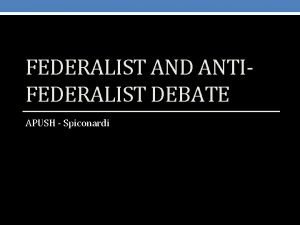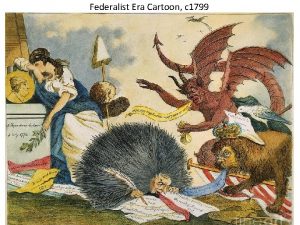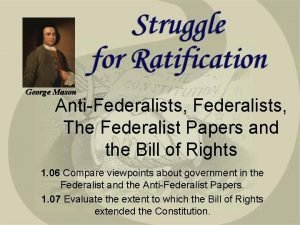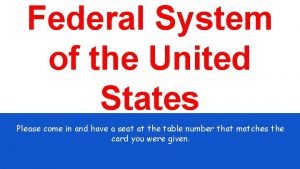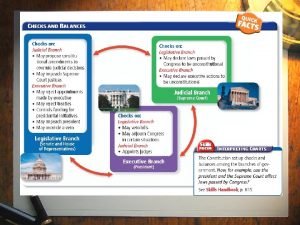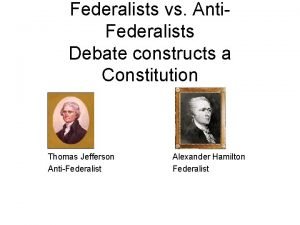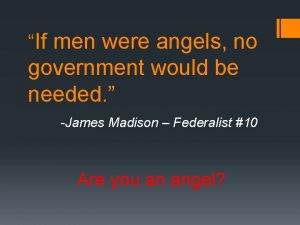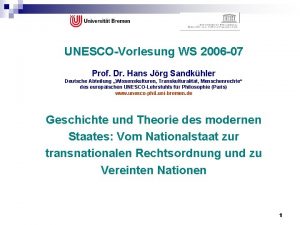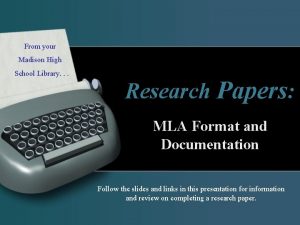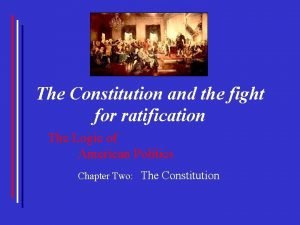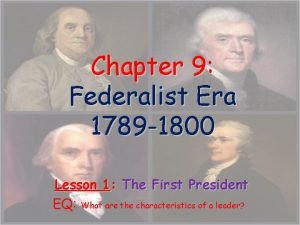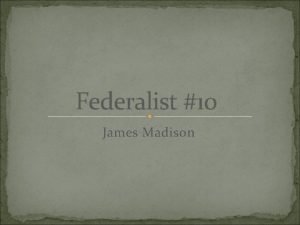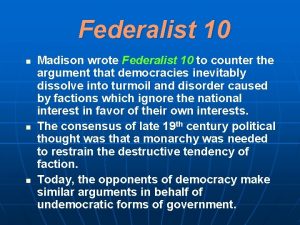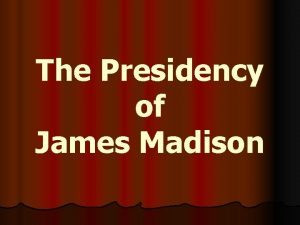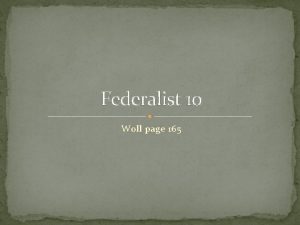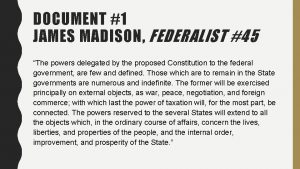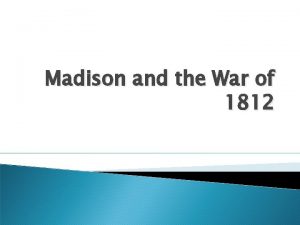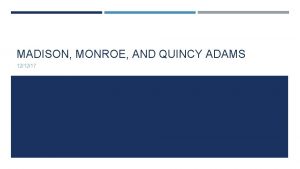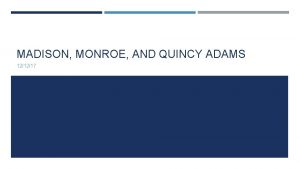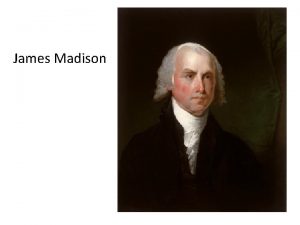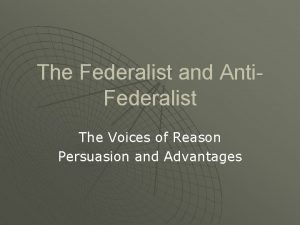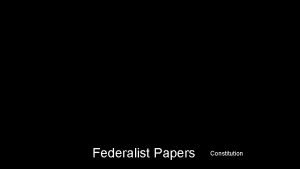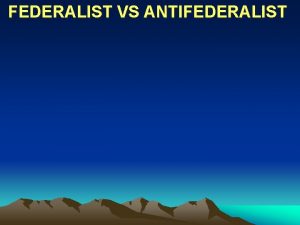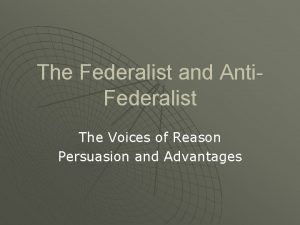Federalist 47 48 51 James Madison How Not


















- Slides: 18

“Federalist 47, 48, 51” James Madison “How Not to Read the Constitution” Lawrence Tribe & Michael Dorf

Definitions: o Federalist n Supporters of ratification of the Constitution whose position promoted a stronger central government.

Anti-federalist o Opponents of ratification of the Constitution and of a strong central government.

Federalist Papers o A collection of 85 articles written by Hamilton, Jay, and Madison under the name of “Publius” – to defend the Constitution in detail.

Lecture: o Madison & the framers believed: n “statesmen should govern” n “strong national government was essential for the preservation of the national interest” n “the Enlightenment and it’s faith in reason, progress, and the ability of men to govern in a deliberate and selfless way” o Mechanism: n Separation of powers n Checks and balances n Goal = “advancement of the national interest” (Lecture Summaries 12)

Madisonian Model & 18 th Century Model of Government o “One in the same” n balanced government o “to prevent selfish political interests from ruling including the selfish majority will” o “to assure deliberative government that defines and carries out the national interest” (Lecture Summaries 13)

No. 47 – Main Argument o “The separation of powers protects liberty” o Criticism and Madison’s Response: n Critics alleged “that the new document does not adhere to the above maxim” (motto) o Because the “legislative, executive, and judicial powers are intertwined. ” n Madison response: o “…separation of powers does not mean total separation. n One branch cannot completely control another. n Overlapping powers (The Setting of… 5)

No. 48 o Main argument: n “Creating ‘parchment barriers’ in the Constitution won’t be enough to maintain separation of powers and the liberty protected by separation of powers. ” n “Madison feared that in a government founded on popular sovereignty, the legislative branch will be the most powerful. ” (The Setting of… 6)

No. 51 o Main argument: n “Ambition must be made to counteract ambition” n Madison’s reasoning: o Each branch n Own will n Independent (as possible) n Ability to resist encroachment from another branch § Ex: Legislature – divided into two houses Executive – veto over legislation (The Setting of… 6)

Marbury v. Madison o Judicial Review o Remember these main points: n Constitution = supreme law of the land n Supreme Court’s duty = “to interpret the Constitution & say what the law is” n “Supreme Court’s interpretation of the Constitution binds both Congress and the President” o therefore, “the Supreme Court has the power of judicial review over Congress and the President” o but, “the Court should exercise judicial selfrestraint in cases involving political questions” (Lecture Summaries 13)

“How Not to Read the Constitution” o Main Argument: n Interpreting the Constitutiono “looking beyond the specific views of the Framers” n Reasoning: o Framework – “balancing liberty against power” o Adapting from generation to generation – “difficult and complex” n Judges should not impose personal viewpoints (The Setting of… 7)

Questions: 1. What was the main purpose, according to James Madison, for Federalist 47? n To examine the actual structure of the government and the division of power between the branches of government.

According to Madison, what was the meaning of the following sayings by Montesquieu: “there can be no liberty, where the legislative and executive powers are united in the same person, or body of magistrates”; “if the power of judging be not separated from the legislative and executive powers”? o “…where the whole power of one department is exercised by the same hands which posses the whole power of another department, the fundamental principles of a free constitution are subverted…” o Separation of power is essential for when one branch of government holds all of the power over the other branches of government it weakens or undermines the basic philosophy of a free constitution.

Explain the following statement in by Madison: “…unless these departments be so far connected and blended, as to give to each a constitutional control over the others, the degree of separation which the maxim requires, as essential to a free government, can never in practice be duly maintained. ” o In order for a free government to function properly it is critical that there be checks and balances of power between and among the branches.

o Discuss: “If men were angels, no government would be necessary. If angels were to govern men, neither external nor internal controls on government would be necessary. ”

Madison expressed the concern about one particular branch having excessive power; explain why and how this was resolved. o The legislative branch tends to dominate in a republican form of government, therefore, the legislative branch needed to be divided – thus we have the Senate and the House of Representatives.

o What is Tribe and Dorf trying to imply regarding the Constitution? n Constitution – “balancing liberty against power” (Woll 47) n Framework, not blueprint (Woll 47) n How to read the Constitution: o “find principles of interpretation that can anchor the Constitution” (Woll 49) n Problem: § Too much room for imagination. (Woll 49) § Judges imposing their own viewpoints

Works Cited Woll, Peter. American Government Reading and Cases. 16 th Ed. Pearson/Longman. New York. 2006. Woll, Peter. Lecture Summaries. Brandeis University. 10 Aug 2005. http: //people. brandeis. edu/~woll/wollwebsites. html Woll, Peter. The Setting of the American System. Brandeis University. 9 Sept 2005 http: //people. brandeis. edu/~woll/pol 14 b. Adobe. html
 What does james madison argue in federalist 10
What does james madison argue in federalist 10 Federalist vs anti federalist apush
Federalist vs anti federalist apush What so
What so George mason quotes anti federalist
George mason quotes anti federalist Federalist vs anti federalist political cartoon
Federalist vs anti federalist political cartoon Federalist or anti federalist quiz
Federalist or anti federalist quiz Anti federalists vs federalists
Anti federalists vs federalists James madison if men were angels
James madison if men were angels Konkurrenztheorie james madison
Konkurrenztheorie james madison War at home and abroad madison
War at home and abroad madison James madison high school library
James madison high school library James madison university rotc
James madison university rotc Not genuine not true not valid
Not genuine not true not valid Criminal profiling of serial killers
Criminal profiling of serial killers Clay lawson and russell odom
Clay lawson and russell odom Nationalist vs federalist
Nationalist vs federalist Whats an anti-federalist
Whats an anti-federalist Chapter 9 lesson 1 the first president
Chapter 9 lesson 1 the first president Federalist no 78 summary
Federalist no 78 summary

